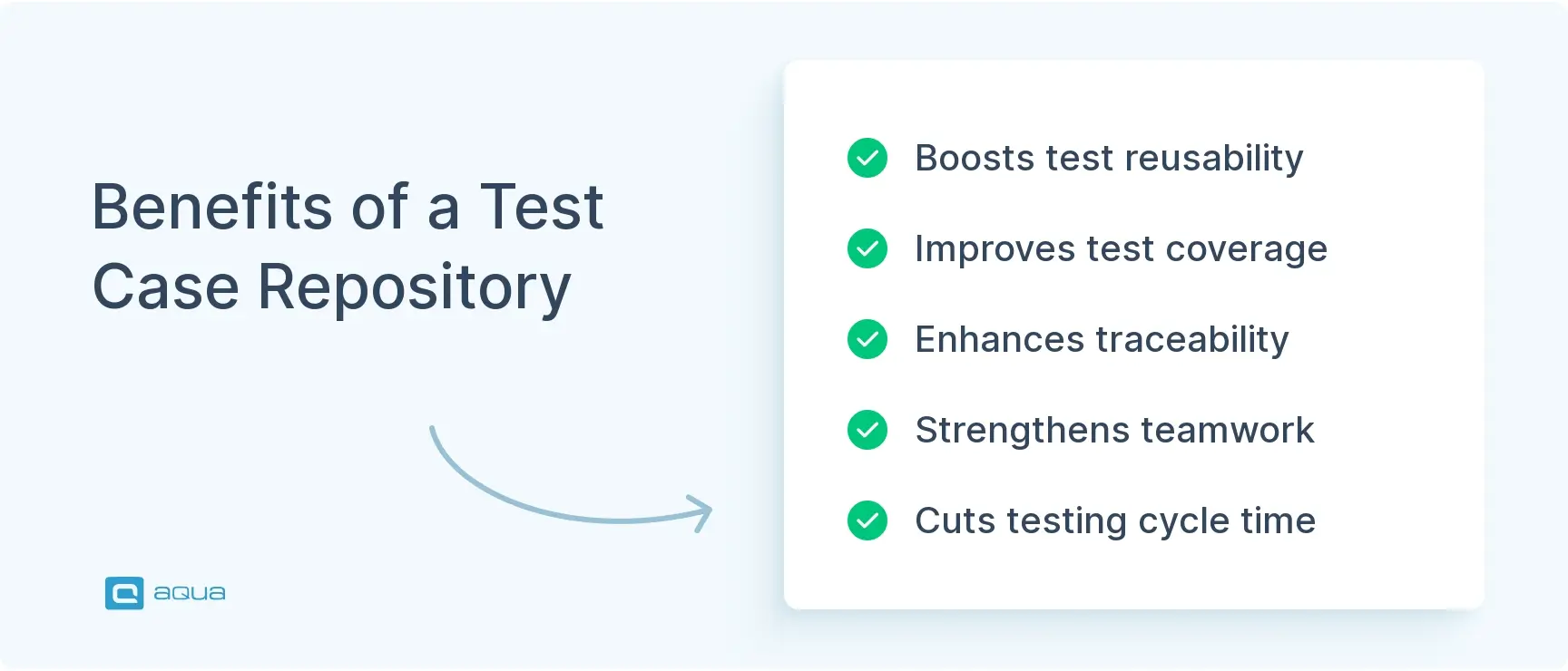What is a Test Case Repository?
A test case repository is a centralised storage system for all your test cases and related testing assets. It’s where your approved test cases live – neatly organised, easily accessible, and properly maintained. It is your team’s single source of truth for what to test and how to test it.
Your test case repository typically includes:
- Test cases – The individual test scenarios with steps, expected results, and pass/fail criteria
- Test suites – Logical groupings of test cases for specific features or testing types
- Test data – Sample inputs needed to execute tests
- Shared test components – Reusable testing elements like login sequences
- Execution history – Records of past test runs and their results
- Requirements links – Connections between tests and the requirements they validate
Unlike a random collection of test documents, a proper repository has structure, version control, and links between related items.
Why Your Team Needs a Test Case Repository
Many teams hesitate to invest time in setting up a proper repository. However, the benefits quickly outweigh the initial setup effort:
Increased Test Reusability
Testing the same functionality repeatedly wastes time and resources. With a centralised repository, your team can:
- Find and reuse existing tests instead of writing new ones for each release
- Quickly assemble regression suites by pulling relevant tests from your test case library
- Create new tests based on established patterns, maintaining consistency across your testing
This test case reusability alone can save hours of work each sprint, especially for features that undergo frequent changes.
Better Test Coverage & Quality
When tests live in a structured repository, gaps in your testing become visible. This visibility helps you:
- Identify untested or under-tested features or requirements
- Maintain consistent testing approaches across your application
- Ensure critical scenarios aren’t overlooked during rapid development cycles
Many teams report finding significant coverage gaps when first organising their tests in a repository—issues that might otherwise remain hidden until problems emerge in production.
Enhanced Traceability for Stakeholders
A repository connects your tests to the requirements they verify:
- Tests link directly to requirements or user stories, showing coverage at a glance
- Areas lacking sufficient test coverage become immediately apparent
- Stakeholders can see concrete evidence of testing completeness
This proves invaluable during audits or when demonstrating testing thoroughness to clients and management.
Improved Team Collaboration
A shared repository also transforms how your team works together. Let’s look at how:
- Everyone accesses the same up-to-date test assets, including cases, test data, or test scenarios, eliminating confusion
- Handoffs between team members become clearer and more efficient
- New QA staff can quickly understand the testing landscape by exploring existing tests
This collaborative environment becomes particularly valuable as teams grow or when working with distributed testing resources.
Substantial Time Savings
The efficiency gains from a well-organised repository add up quickly:
- Testers spend less time searching for relevant tests and more time executing them
- Duplicate test writing becomes a thing of the past
- Test planning accelerates as you can quickly assess what exists and what needs to be created
Time savings translate directly to faster release cycles without sacrificing quality.

You can get all these benefits by using a centralised Test Management System (TMS) with advanced test case management features. And that is, where aqua cloud comes into the equation.
With aqua cloud, your test cases are not scattered; they are centralised in one, easy-to-understand platform. Aqua gives you 100% traceability, test coverage and visibility, as you can link each of your test cases back to its fitting requirement. The nested test cases feature allows you to reuse important test cases without the need to create them from scratch. Aqua’s AI Copilot is revolutionary: you can generate test cases from requirements in just a few seconds, with 1 click and save 98% time compared to the manual method. So what are you waiting for?
Build a 100% centralised repository of test cases with a few clicks
Test Case Repository for Automated and Manual Testing
Your repository approach differs slightly for manual versus automated tests, but you’ll want both in your central system. Setting up a test repo for automated testing requires different considerations than for manual testing, though both are essential.
| Aspect | Manual Testing Repository | Automated Testing Repository |
|---|---|---|
| Format | Detailed step-by-step instructions with visual elements | Scripts in programming languages with assertions |
| Tools | Test management platforms (aqua cloud) | Version control systems (Git) + test framework files |
| Updates | Updated by testers through UI forms | Updated through code commits and pull requests |
| Execution | Run by human testers following instructions | Executed by automation frameworks/CI pipelines |
| Results | Manually recorded after execution | Automatically captured and reported |
| Maintenance | Requires periodic reviews to stay current | Maintained alongside code changes (often by developers) |
The ideal approach? Create a unified repository where:
- Manual test cases are stored in your test management tool
- Automated scripts live in your code repository
- Both are linked through IDs or naming conventions
- Automation execution results feed back to the test management tool
This kind of unified model gives you the complete picture of what’s being tested manually, what’s automated, and the current state of both.
Using aqua cloud to manage manual & automated tests.
Integrates well with Jira.
Key Features of a Test Case Repository
Your test case repository will either become your team’s strength or just another tool that collects digital dust.
We’ve all seen it happen – someone sets up a shiny new system for organising test cases, everyone uses it enthusiastically for a few weeks, and then it slowly becomes that place where information goes to die. Meanwhile, the really useful test cases end up scattered across wikis, spreadsheets, and people’s heads.
The difference between a repository that thrives and one that gets abandoned is choosing features that actually fit how your team works. You need capabilities that make sharing knowledge easier, not harder. Features that save time instead of creating busywork. And most importantly, functionality that grows with your testing needs rather than boxing you in.
Here are the make-or-break features that determine whether your test case repository becomes indispensable:
Organisational Structure
- Hierarchical folders/suites for logical grouping
- Tagging system for cross-cutting concerns (smoke tests, regression tests)
- Custom fields to add metadata to tests
Search and Filtering
- Quick keyword search across all test cases
- Advanced filtering by attributes (status, priority, module)
- Saved views for commonly used filters
Version Control
- History of changes to each test case
- Ability to compare different versions of a test
- Option to revert to previous test versions
Integration Capabilities
- Connection to requirements/user story management (e.g., JIRA)
- Hooks into CI/CD pipeline for automated test execution
- Integration with defect tracking
Collaboration Tools
- Comments and discussion threads on tests
- Notifications for test changes
- Review workflows for new or updated tests
Reporting and Metrics
- Coverage reports showing requirements-to-test mapping
- Execution status dashboards
- Trend analysis for test results over time
Popular test case repository tools that offer these features include:
- Commercial options: aqua cloud, Xray for Jira, Azure Test Plans
- Open-source alternatives: TestLink, Kiwi TCMS
The right tool depends on your team size, budget and integration needs. Many teams select tools that integrate with their existing development platforms, like Jira add-ons for teams already using Atlassian products.
Aqua cloud, an all-around TMS, offers you the smoothest integration with Jira. You can execute test cases in aqua while defects automatically appear in Jira, or update a ticket priority in one tool and watch it instantly sync everywhere. No more duplicate data entry, no more hunting for the latest requirements across different platforms, and no more confusion about who changed what. With aqua’s integration, your developers stay comfortable in Jira while your QA team gets industry-leading test management capabilities – all perfectly synchronised in real-time. From linking requirements and establishing dependencies to syncing attachments and maintaining clear accountability, aqua cloud eliminates the friction that slows teams down. As a result, your dev and QA efforts finally move in perfect harmony, letting you focus on building great software instead of managing tools.
Combine Jira with a TMS in perfect sync
Creating and Maintaining a Test Case Repository
Most test case repositories fail not because they’re built wrong, but because they’re abandoned after launch.
You’ve probably seen this cycle before – initial enthusiasm, detailed planning, a few months of diligent updates, then gradual neglect until the repository becomes outdated and useless. The teams with thriving repositories understand something crucial: building it is the easy part. Keeping it alive and valuable is where the real work begins.
Success comes down to designing for maintenance from day one, not treating it as an afterthought:
1. Set up the structure
Your repository needs a logical organisation that makes tests easy to find:
- Hierarchical folders or suites that mirror your application modules
- A tagging system for cross-cutting concerns (smoke tests, regression tests)
- Custom fields to add useful metadata to tests
The right structure makes finding the right tests intuitive, even as your repository grows to hundreds or thousands of tests.
2. Populate with comprehensive test assets
A repository is only as good as its content. Focus on building a comprehensive collection:
- Test cases with clear steps, expected results, and execution criteria
- Test scenarios that cover end-to-end workflows and user journeys
- Test data sets including both valid inputs and edge case variations
- Environment configurations and setup requirements
- Reusable test components that can be shared across different scenarios
Quality matters more than quantity – each asset should be well-documented and maintainable.
3. Link to requirements
As your application evolves, your tests will too. Version control helps you:
- Track the history of changes to each test scenario
- Compare different versions to understand what changed
- Revert to previous versions when needed
This history provides context for why tests were updated and ensures you can always return to a working version.
4. Implement review processes
Quality control extends beyond individual test creation:
- Peer review processes for new test cases and scenarios
- Validation workflows for test data accuracy and relevance
- Approval gates for changes to critical test assets
- Regular audits to identify outdated or redundant content
These processes ensure your repository maintains high standards as it scales.
5. Maintain diligently
Testing is a team sport, and your repository should support collaboration:
- Comments and discussion threads on specific tests
- Notifications when tests change or need review
- Review workflows for new or updated test cases
These collaborative features ensure everyone stays aligned on testing approaches and changes.
6. Optimise continuously
Your repository should provide insights beyond just storing tests:
- Coverage reports showing how well requirements are tested
- Execution status dashboards for test runs
- Trend analysis showing test results over time
These metrics help you demonstrate testing progress and identify problem areas.
Remember: your repository is only as good as your commitment to maintaining it. Schedule regular grooming sessions to keep it relevant and efficient.
As a former software developer turned QA, I see test case management and test plans like developer documentation but for QA. When I look at developer documentation I see how it has evolved and feel QA documentation should evolve as well.
Roles and Responsibilities in Test Case Management
Without clear ownership, even the best test case repository becomes redundant, where nobody feels responsible for keeping things current.
You’ve probably seen this scenario: someone creates a comprehensive test repository, everyone contributes initially, but then gradually it becomes unclear who should update outdated cases, who approves new scenarios, or who maintains the test data. Before long, people start working around the repository instead of with it, and all that initial effort goes to waste.
The most successful test repositories should be more than well-organised; they should have clear ownership at every level. When everyone knows their role and feels accountable for specific aspects, maintenance becomes natural rather than neglected:
QA Engineers
- Create and update test cases
- Execute tests and record results
- Identify tests for automation
QA Lead/Manager
- Define the repository structure and standards
- Review test cases for quality and coverage
- Generate reports for stakeholders
- Ensure repository maintenance
Developers
- Provide input on technical test scenarios
- Review test cases for technical accuracy
- Contribute to automated test scripts
- Help troubleshoot test environment issues
Product Owners
- Review tests for business requirement coverage
- Clarify acceptance criteria that inform test cases
- Prioritise testing areas based on business risk
DevOps/CI Engineers
- Set up automation infrastructure
- Integrate the repository with CI/CD pipelines
- Ensure test results flow back to the repository
The key to success? Clear ownership but shared responsibility. Your test repository isn’t just “QA’s thing”, it’s a team asset that everyone contributes to and benefits from.
Real-World Applications of Test Case Repositories
Let’s look at how you can use test case repositories to tackle common testing challenges in different industries:
Scenario 1: The Sprint Time Crunch
Imagine you work on an e-commerce platform with two-week sprints. Your team is constantly rushing through regression testing, and customers regularly report bugs in features you thought were solid. Each release feels like gambling with your site’s reputation.
After implementing a structured test repository, your team:
- Organizes test cases around key customer journeys (browsing, checkout, returns)
- Adds priority tags to identify which tests matter most for each feature
- Connects automated tests to run whenever developers check in code
Within a few months, everyone notices the difference:
- The team completes regression testing in half the time
- Customer complaints about bugs drop significantly
- New team members quickly learn what to test and how
Now when a developer asks, “Did we test this payment flow?” you can instantly pull up relevant tests rather than wondering if they exist at all.
Scenario 2: The Compliance Challenge
Picture yourself on a financial services team building a banking app. Your product manager constantly reminds everyone about the regulatory audits coming up, and the stress is mounting. Nobody wants to be responsible for failing an audit.
Your team creates a test repository focused on compliance:
- Each regulatory requirement links directly to specific test cases
- Every test execution maintains a permanent, time-stamped record
- All changes to test cases are tracked with detailed history
When the auditors arrive, the difference is striking:
- You can demonstrate exactly how each requirement was tested
- Historical evidence shows consistent testing over time
- Managers can confidently discuss testing coverage with auditors
What was once a stressful audit process becomes routine. Your team even reuses this approach for other compliance-heavy projects.
With aqua cloud, a test case management solution, your test cases live in a single, centralised repository—no more digging through scattered documents or siloed tools. You gain full traceability and test coverage by directly linking every test case to its corresponding requirement. This means you always know what’s tested, what isn’t, and why. With aqua’s nested test case feature, you can reuse core test logic across projects without reinventing the wheel. It is perfect for regression and compliance scenarios. And with aqua’s AI Copilot, generating test cases from requirements takes just one click. It automates the grunt work and cuts time spent on test design by up to 98% compared to manual methods. Apart from that, aqua cloud is compliant with the highest security standards, and ISO, FMEA, and FDA certified, making sure all your testing activities remain secure and safe. Add automation and project management integrations, one-click requirements, test data generation, and native bug-recording integration, and you have an all-around test case management software in your hands.
Achieve 100% centralisation for your manual and automated tests
Conclusion
By centralising your test assets, you gain efficiency through reuse, confidence through traceability, and quality through consistency. The most successful QA teams treat their repository as a living system: continually maintained, regularly pruned, and constantly evolving alongside the application. If you’re still managing tests in scattered spreadsheets or documents, consider this your wake-up call. The investment in setting up a proper repository pays dividends quickly through reduced duplication, better coverage, and smoother collaboration.


















